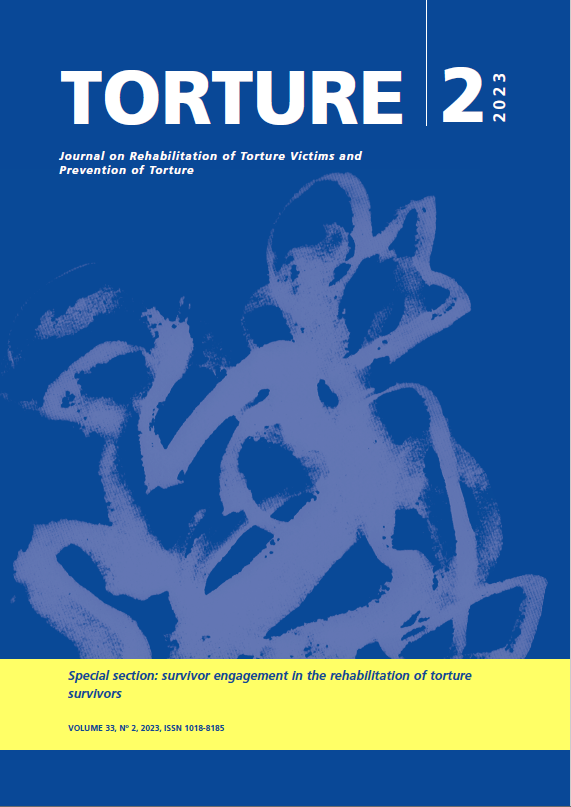Survivor engagement: Experience with an advocacy-based model in Washington, D.C.
DOI:
https://doi.org/10.7146/torture.v33i2.135716Keywords:
advocacy, torture, survivor, survivor engagementAbstract
Introduction: As an IRCT member organization supporting survivors of torture, the Torture Abolition and Survivor Support Coalition (TASSC) International places survivor engagement at the core of their work, aiming to provide safe and inclusive spaces for survivors to speak out and take meaningful action to prevent torture. This article describes TASSC’s model for engaging survivors in advocacy and presents evidence on the personal impacts such engagement can have. Method: Each year from 2016-2019, TASSC administered a simple survey with questions for survivors to complete after their annual “Advocacy Day” in Washington D.C. Quantitative and qualitative data was collected to inform internal service provision and the design of future events. Results: Across the four years a total of 140 survivors and compatriot human rights advocates participated in the annual Advocacy Day, and a majority completed the surveys. In their survey responses, survivors agreed they had many positive thoughts and feelings after advocacy. Their reported positive experiences included a sense of being listened to and heard by an understanding and responsive audience, the power of feeling part of a group that was speaking out on behalf of themselves and others, and a sense of motivation and hopefulness for the future. Discussion: Although undertaken primarily to inform internal processes, TASSC’s surveys with survivors who engaged in advocacy shed light on the potential value of well-designed advocacy experiences. Consistent with past research, survivors reported strong motivations around and compelling benefits from participating, despite the challenges that the deeply personal nature of their engagement could present. This feedback suggests TASSC has a strong model that could be replicated elsewhere, but it would be beneficial to further investigate the experiences of survivors engaging in advocacy in other country settings.
References
Agger, I., Igreja, V., Kiehle, R., & Polatin, P. (2012). Testimony ceremonies in Asia: Integrating spirituality in testimonial therapy for torture survivors in India, Sri Lanka, Cambodia, and the Philippines. Transcultural Psychiatry, 49(4), 568–589. https://doi.org/10.1177/1363461512447138
Brounéus, K. (2008). Truth-telling as talking cure? Insecurity and retraumatization in the Rwandan gacaca courts. Security Dialogue, 39(1), 55–76. https://doi.org/10.1177/0967010607086823
Byrne, C. C. (2004). Benefit or burden: Victims’ reflections on TRC participation. Peace and Conflict, 10(3), 237–256. https://doi.org/10.1207/s15327949pac1003_2
Dhital, Y., Mishori, R., Tromiczak, C., & O’Connor, S. (2018). Psychological Impact on Survivors of Torture of Participation in an Advocacy Event: A Pilot Study. Poster presented at the Georgetown University School of Medicine: Population Health Scholar Track presentation day, Washington D.C.
Delker, B.D., Salton, R. & McLean, K. C. (2020) Giving Voice to Silence: Empowerment and Disempowerment in the Developmental Shift from Trauma ‘Victim’ to ‘Survivor-Advocate’, Journal of Trauma & Dissociation, 21:2, 242-263, DOI: 10.1080/15299732.2019.1678212
Fields, L., Valdez, C. E., Richmond, C., Murphy, M. J., Halloran, M., Boccellari, A., & Shumway, M. (2020) Communities Healing And Transforming Trauma (CHATT): A Trauma-Informed Speakers’ Bureau for Survivors of Violence, Journal of Trauma & Dissociation, 21:4, 437-451, DOI: 10.1080/15299732.2020.1770149
International Rehabilitation Council for Torture Victims (2022). IRCT Strategy 2022-2025. Retrieved from: https://irct.org/our-strategy/
Jorgensen, M. M., Modvig, J., Agger, I., Raghuvansh, L., Shabana Khan, S., & Polatin, P. (2015). Testimonial therapy: Impact on social participation and emotional wellbeing among Indian survivors of torture and organized violence. Torture: Quarterly Journal on Rehabilitation of Torture Victims and Prevention of Torture, 25(2), 22–33.
Laplante, L. J. (2007). Women as political participants: Psychosocial postconflict recovery in Peru. Peace and Conflict, 13(3), 313–331. https://doi.org/10.1080/10781910701471355
Mohan, M. (2009) The Paradox of Victim-Centrism: Victim Participation at the Khmer Rouge Tribunal. International Criminal Law Review. 9, (5), 733-775. Research Collection School Of Law. https://ink.library.smu.edu.sg/sol_research/830
O’Connor, S., Byimana, L., Patel, S., & Kivlighan, D. M., Jr. (2021). Corrective Political Experiences: Psychological Impacts of Public Testimony for Survivors of Torture. Professional Psychology: Research and Practice, 52(6), 588–599. http://dx.doi.org/10.1037/pro0000414
Patel, N., & Williams, A. Rehabilitation for torture survivors: Six evidence myths and their implications for future research. Torture, 2022 (32), 227-250. http:// dx.doi.org/10.7146/torture.v32i1-2.131776. PMID: 35950436.
Puvimanasinghe, T. S., & Price, I. R. (2016). Healing through giving testimony: An empirical study with Sri Lankan torture survivors. Transcultural Psychiatry, 53(5), 531–550. https://doi.org/10.1177/1363461516651361
Rees, S., Tsey, K., Every, A., Williams, E., Cadet-James, Y., & Whiteside, M. (2004). Empowerment and human rights in addressing violence and improving health in Australian indigenous communities. Health and Human Rights, 8(1), 94–113.
Sadiq-Tang, S. (2018). Building survivor activism: An organisational view. Torture Journal, 28(2), 140–149. https://doi.org/10.7146/torture.v28i2.106853
Shalhoub‐Kevorkian, N. (2005). Voice therapy for women aligned with political prisoners: A case study of trauma among Palestinian women in the second intifada. Social Service Review, 79(2), 322–343. https://doi.org/10.1086/429141
Stammel, N., Burchert, S., Taing, S., Bockers, E., & Knaevelsrud, C. (2010). The survivors’ voices: Attitudes on the ECCC, the former Khmer Rouge and experiences with civil party participation, (December).
Stepakoff, S., Shawn Reynolds, G., Charters, S., & Henry, N. (2015). The experience of testifying in a war-crimes tribunal in Sierra Leone. Peace and Conflict, 21(3), 445–464. https://doi.org/10.1037/pac0000096
Suarez, E. B. (2011). Surviving the "Sasachacuy Tiempu "[difficult times]: The resilience of Quechua Women in the aftermath of the Peruvian armed conflict. ProQuest Dissertations and Theses. University of Toronto.
Taylor, D. (2014). Victim Participation in Transitional Justice Mechanisms: Real Power or Empty Ritual? The Netherlands: Impunity Watch.

Downloads
Published
How to Cite
Issue
Section
License
Copyright (c) 2023 Torture Journal

This work is licensed under a Creative Commons Attribution-NonCommercial-NoDerivatives 4.0 International License.
We accept that some authors (e.g. government employees in some countries) are unable to transfer copyright. The Creative Commons Licence Attribution-NonCommercial-NoDerivatives 4.0 International (CC BY-NC-ND 4.0) covers both the Torture Journal and the IRCT web site. The publisher will not put any limitation on the personal freedom of the author to use material contained in the paper in other works which may be published, provided that acknowledgement is made to the original place of publication.

